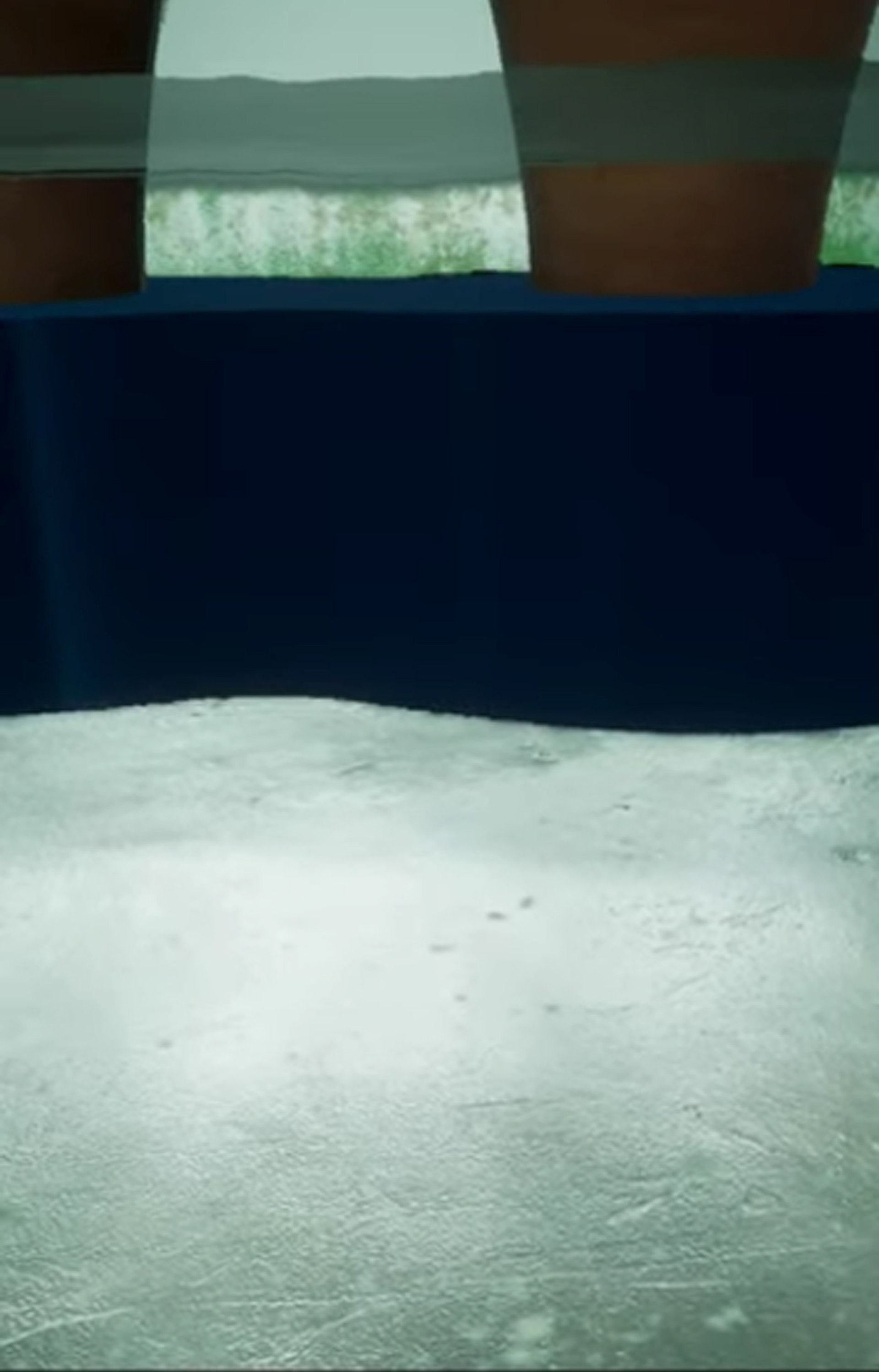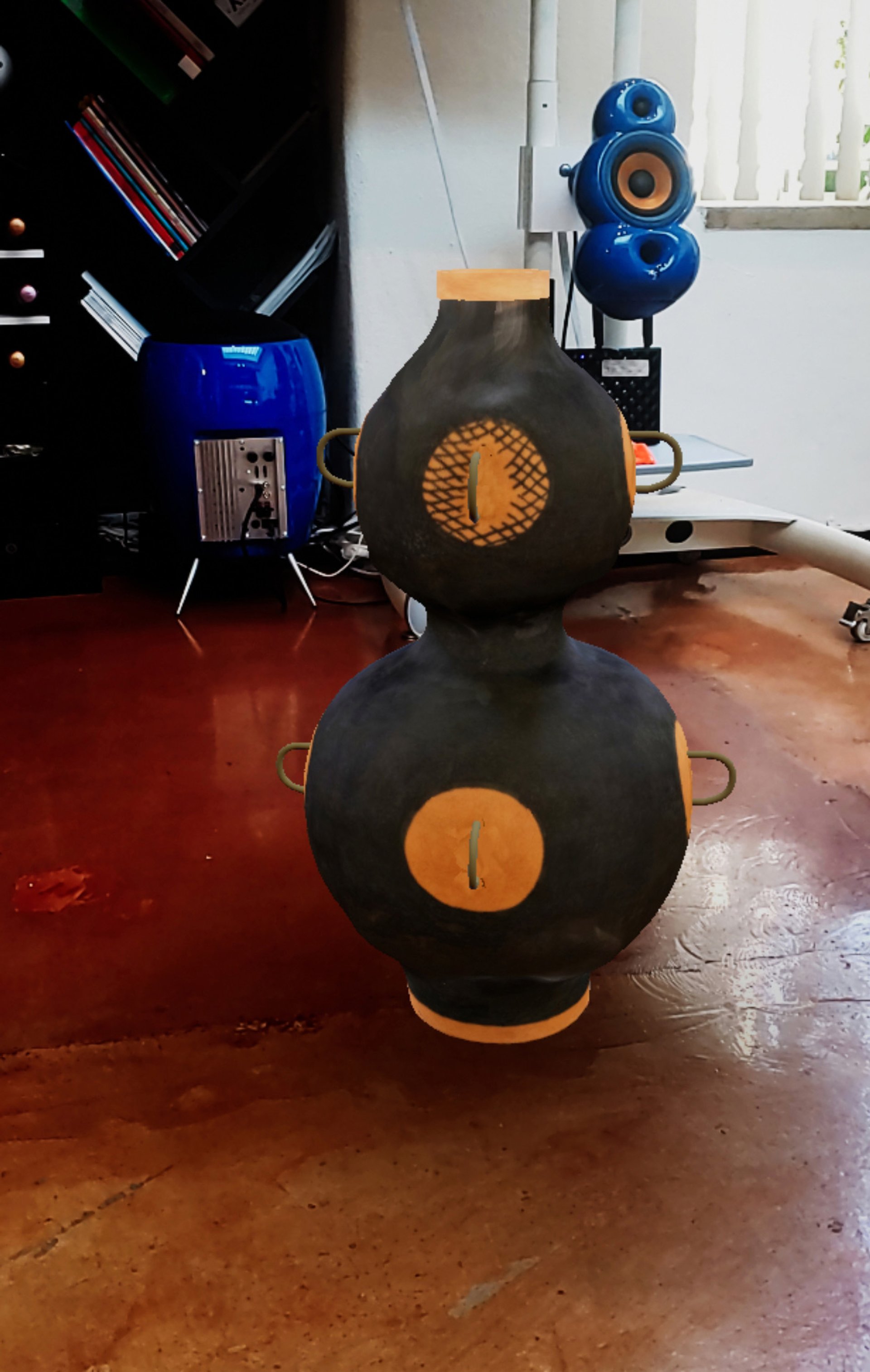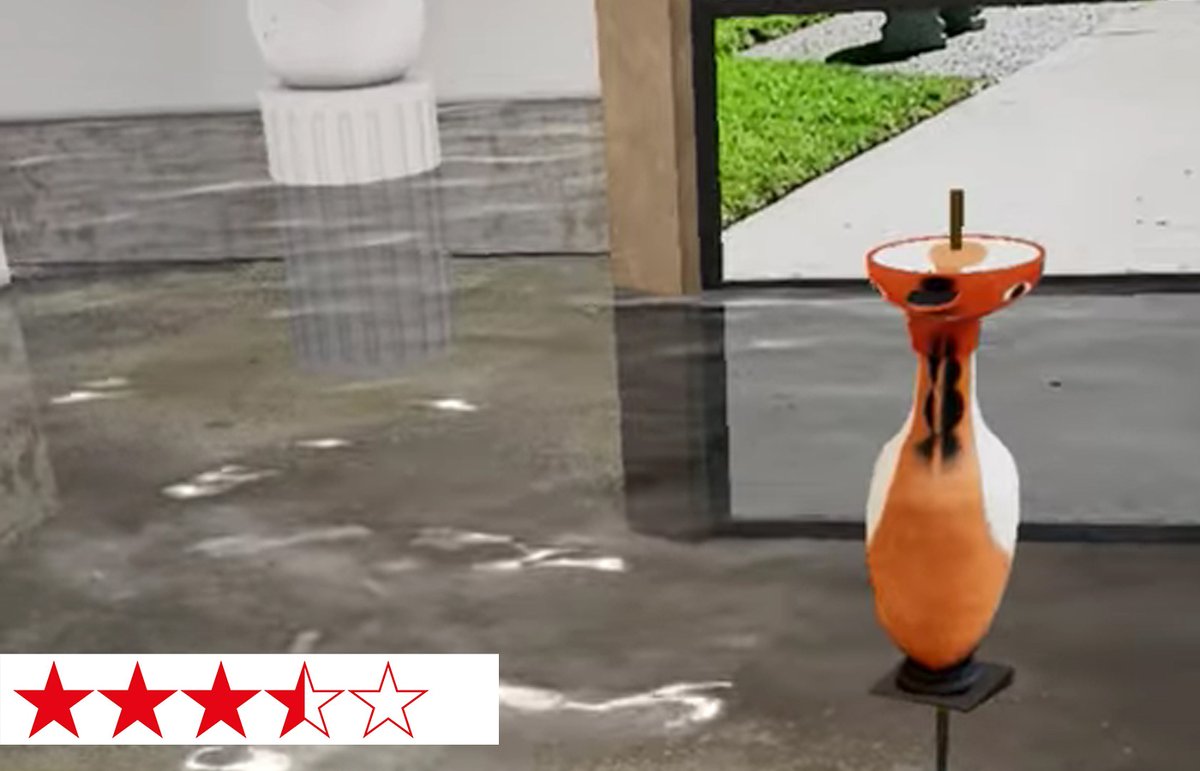How neat the fold of time, how easily the crease forgotten: Cammie Staros
Produced by: Another Reality Studio for The Lux Art Institute
An augmented reality presentation of the artist Cammie Staros's new ceramics presented in a white-walled space—the AR Portal—that slowly fills with water submerging the works and the viewer.
Users can also use a section of the app—AR Home—to place individual pieces of Staros's work as augmented reality objects in their own home.
Staros, a Los Angeles-based artist and John Simon Guggenheim Memorial Foundation Fellow, was artist-in-residence at the The Lux Art Institute—a non-profit organisation based in Encinitas, near San Diego, California—in the summer of 2020.
Where to Find it
For iOS—requires iOS 11.0 or later—download the Lux Institute free downloadable app from the App Store
For Android, download the Lux Institute free downloadable app from Google Play
They Say:
A re-imagined, virtual version of Lux’s exhibition space. Staros presents her sculptures in a virtual Lux gallery, submerged beneath risen seas
Cammie Staros: For the past several years I've been considering the museum as a future ruin, abandoned by humans and reclaimed by nature. As the posited idea of a deserted exhibition became a current reality, it presented real-world obstacles and opportunities for the planned presentation of my work. Lux's proposal to design a virtual show allowed me to engage an imagined future that now feels all too present.

Staros's work slowly becomes submerged
The XR panel's ratings
Giving an overall panel rating of 3.5/5 stars.
We Say:
Environmentally apocalyptic scenarios are exactly what Cammie Staros's VR/AR exhibition provokes
Gretchen Andrew: As a kid I often wondered what of my life might remain as ruins and what story they might tell. Would my teddy bear be seen as a God of childhood protection? What might the future make of his one eye? But so little survives a flood, and less so flames, only jewellery, filing cabinets, grills, and cookware. I write having recently driven from northern Utah to Los Angeles, up to Monterey, Portland, and across Idaho back to Utah where there seemed to not be an inch that wasn’t clouded by wildfires. As it seems increasingly probable that our homes if not our whole civilisation could end in fire—with flames having caressed the Getty Center last year, and ceramicist Steve Harrison surviving the Australian wildfires by climbing into this kiln—now is a good time to discuss the way the VR and AR work that this panel reviews is situated in the discussion of long-term preservation.
Such environmentally apocalyptic scenarios are exactly what Cammie Staros's VR/AR exhibition provokes. The Lux Art Institute application can be downloaded from either the Android or Apple store and presents an exhibition of Cammie Staros's ceramics inside a gallery slowly submerging under a rising sea level. Eventually, the works and even the viewer find themselves under water with the works and the fishes. Some might recall the torrential rains of 2015 Art Basel Miami. While 2020 Art Basel Miami Beach will not take place this year because of the Covid-19 pandemic, Scientific American also names Miami as the most vulnerable coastal city worldwide. We could have as little as 15 years to party in the city where the heat is on.

Eventually, the viewer is fully under water
Cammie Staros's work modifies ancient Greek vessels, further provoking questions of how one past civilisation might be understood by another. When this panel reviewed the Metropolitan Museum of Art’s AR Zemi Cohoba Stand, we briefly discussed AR’s ability to preserve precious objects subject to the uncertainties and deterioration of time. However, as many museums are discovering, technology—with its ceaseless planned obsolescence—is more vulnerable to time than most physical materials. How useful is the first iPhone only 13 years after it was launched?
Earlier this year, this panel reviewed Olafur Eliasson’s AR work on Acute Art, where I was disturbed by how the illusion of controlling the weather undercut the artist's tight and serious concern for the environment. By contrast, Staros’s has us helpless as we are submerged with her works.
Is the app easy to use?
The virtual gallery was so expansive that I couldn’t get anywhere near the artworks! It would take a truly palatial house to fully experience the virtual gallery part of the showEron Rauch
Carole Chainon: The app is easy to use if your device is compatible with AR technologies. The user interface is simple and within three phone taps I am in the AR gallery looking at Cammie Staros’s works.
Dhiren Dasu: I found it quite easy to use. An onscreen prompt alerting non-technical users to “click here to place object or portal” would be helpful. An explanation of the difference between AR Portal and AR Home would also be good.
Seol Park: Finding and downloading the app is easy, as is launching the viewing experience. Within the app, the two ways of experiencing the artist's work—the "Portal" versus placing the artist's vessels at home—are clearly labelled.
Eron Rauch: For the good, the app is cleanly designed with a familiar layout from museum show websites. However, I encountered a number of technical barriers: First, the Lux app does not support my older Samsung S7—this means the Lux app does not show up in a Google Play store search for older devices. When I switched to a brand new Pixel, the second user-experience hitch is less critical, but informative for interface designers. The two available AR experience buttons are small, have vague icons, confusingly evocative names “AR Portal” and “AR Home”, with no explanation of what they actually do.
The third technical issue is perhaps most philosophically interesting to ponder. The Lux app makes the assumption that you live in a really large dwelling. I live in Los Angeles and tried the virtual gallery in both my [small] studio and main [small] apartment living space and neither were anywhere near large enough to accommodate the gallery. In fact, the virtual gallery was so expansive that I couldn’t get anywhere near the artworks! It would take a truly palatial house to fully experience the virtual gallery part of the show.
Related: I tapped the “?” icon to see if there was a way to fix this issue, but it didn’t open a help popup, and instead caused the app to jump somewhere else in the gallery. Unsettlingly magical, which is not out of character with the mythical era of art referenced by Staros, but very likely merely a glitch.
How good is the art?
Staros’s playful takes on classical artistic themes such as Leda and the Swan stood outDhiren Dasu

Shared physiognomy: Staros’s A Sharp Intake of Breath rendered in AR in Dhiren Dasu’s studio
Carole Chainon: The artworks are well recreated. I could see certain small cracks on the pottery. I love the shapes of Staros’s works, especially the Whale piece. Having two options to view the artworks, individually and within the gallery, helped provide a context to different pieces of work.
Dhiren Dasu: I thought the art was clever, quirky and very well executed. Staros’s playful takes on classical artistic themes such as Leda and the Swan stood out. I also really liked A Sharp Intake of Breath. I appreciated very much that the work was a visual of the title. This piece sat very well with the speakers in my studio thanks to the shared physiognomy.
Seol Park: Bravo to the artist. I very much enjoyed Staros's work and her imaginative submerged staging, which brings an added mystery and sense of discovery to this virtual exhibition, without which the place-the-vessels-at-home presentation alone would have felt flat. As for the objects, her vessels look curious and animated, seeming to hold stories to tell.
Eron Rauch: Staros’s art is quite exceptional. I hadn’t spent too much time with it before, but the longer I spent with the works the more I appreciated the excellent and subtle execution which lets them be effortlessly pleasurable to look at, but also intervene in their own presentation in critical ways. A bit like Brancusi’s inclusion of the plinths and pedestals as part of the sculpture, Staros’s works are very self-aware of the way they ingest and mutate historical narratives and tropes of cultural valuation.
What is gained by viewing in VR/AR rather than In Real Life?
As I was exploring the objects both above and below the water, virtually speaking, I noticed the water level rising. The psychological pressure and urgency coming from it was actually 'felt'Seol Park

The AR Portal cannot be replicated in real-life… without destroying the art and those Gucci loafers of the well-heeled collector
Carole Chainon: Being able to get as close as we digitally can to the artworks, explore every aspect and to take our time. Augmenting the portal with water gives us a look into the artist's mind and how Staros want us to view her artworks, which I appreciated. Having said that, the portal is very spacious and, when visiting from home, you may well be restrained by your own physical walls and thus be unable to see the entire collection. This is a portal to explore in a location with a lot of space.
Dhiren Dasu: The AR Portal is an experience that cannot be replicated in real-life… at least without destroying the art and those Gucci loafers of the well-heeled collector! The water on the floor makes for a nice touch and sells the illusion of an abandoned museum in the future world. The idea of a portal that reveals a hitherto unknown seam into a magical space is always fun.
Seol Park: An artistic medium, including new technologies such as AR/VR, is especially meaningful when it allows artists to create expressions that are otherwise unachievable. In this case, Staros and the Lux Institute take us to a space submerged in water. As I was exploring the objects both above and below the water, virtually speaking, I noticed the water level rising. The psychological pressure and urgency coming from it was actually 'felt'.
Eron Rauch: Given the relationship of Staros’s work to formal art institutions and their display methods of artefacts of classical antiquity, it is really important to see these works inside a museum context. AR gives us an approximation of this presentation, which even though it is incomplete, goes a long way to help fill out our imagination of that context without physically visiting the show.
What medium-specific qualities of VR/AR does it employ?
A representation of a gallery show with a fantastical element that would be impractical to execute otherwiseEron Rauch
Carole Chainon: I have been a big fan of AR portals ever since ARKit launched almost three years ago, as they can enhance the sense of discovery and wonder. I always thought that it would be a great way to visualise artworks and was thrilled to see it employed here. I really enjoyed the portal and that it was "augmented" with water.
Dhiren Dasu: Standard usage of device camera, 3D scanning of the art, photography, 3D animation.
Seol Park: This project successfully combines 3D scanning/modelling and photogrammetry reconstruction of real-world objects (Staros's vessels) with elements of artistic creation native to AR (the interactive scenography and passage of time expressed via the rising water).
Eron Rauch: Staros’s show is the first app/show combination we’ve reviewed that combines a representation of a gallery show with a fantastical element that would be impractical to execute otherwise. In this case, the gallery floor is flooded with a layer of water. This provides an additional, allusive context relevant to the sculptures’ references, which are often recovered from underwater sites. All without the colossal mess letting visitors muck about in such a wet space would wreak across the rest of a physical museum.
An unintentional medium-specific quality that occurs in Lux’s placed-object AR system is something called “clipping”. It's what happens when you “enter” an otherwise solid object in 3D graphics. When you use the placed-AR feature of the Lux app, you can see one of Staros’s sculptures in your home, but if you walk “into” it, the app has to do something to handle that situation. In this case, Lux relies on a common solution, which is clipping: removing and displaying whatever bits of the digital model to make it visible from where you are. In practical terms, this means seeing the artwork from physically impossible angles, such as along both the inside and outside of the object at once, if you split the wall; or standing directly in the middle, looking at an inside of the 3D model render. These are views that do not exist in the actual sculpture. This might seem technical, but it matters because these practical programming solutions create experiences with artworks that are not intended or desirable for the artist.
Does it break new ground technically?
The AR Portal is something I haven’t seen beyond real estate and entertainment purposes and it fits the medium wellCarole Chainon
Carole Chainon: The experience does not break new grounds, ARKit and ARCore have been around for a few years but the AR Portal is something I haven’t seen beyond real estate and entertainment purposes and it fits the medium well.
Dhiren Dasu: I did not feel that it broke any new technical ground. However, it was a cohesive and interesting experience. It succeeds at presenting Staros’s art in a dynamic context whilst allowing me to focus on the work and enjoy it in a way that I would most likely not experience in any other setting
Seol Park: Though the individual technical elements employed may not necessarily be groundbreaking per se, they were brought together tastefully to present a holistic story. I enjoyed dipping in and out of the water and looking at the vessels underwater.
Eron Rauch: The Lux app itself has no especially new features, though it is nice to see more apps (such as Vortic, too) featuring multiple digital presentation modalities of the same show in the space hub. But like an unfortunately large number of the apps and platforms we’ve reviewed, Lux is plagued with bugs and frustrating user interface decisions.
The Art Newspaper's XR Panel
Gretchen Andrew is a Search Engine Artist and Internet Imperialist who programs her vision boards to manipulate the internet with art and desire.
Carole Chainon is the co-founder of JYC, a XR development and production studio based in LA with a presence in Europe, creating XR experiences for the entertainment and enterprise sector. She is also a Spark AR Creator.
Dhiren Dasu is a digital media creator and consultant. His areas of speciality include photography, film, virtual space, graphic design, visual effects, animation, and audio production. Dasu, in his fine art persona as Shapeshifter7, makes artworks that echo and recompose the architectural spaces he photographs, turning them into immersive spaces while exploring the nexus of photography, collage, symbols, and perception.
Seol Park lives at the intersection of technology, art, and branding. She has worked with technology leaders such as Microsoft and INTEL, produced XR content worldwide, and at present guides global branding at LG with emphasis on digital expressions and cultural engagement. Seol was named "4 Under 40" by Sotheby's Institute in 2019.
Eron Rauch is an artist, writer, and curator whose projects explore the infrastructure of imagination, with a focus on subcultures, video games, and photography history.




